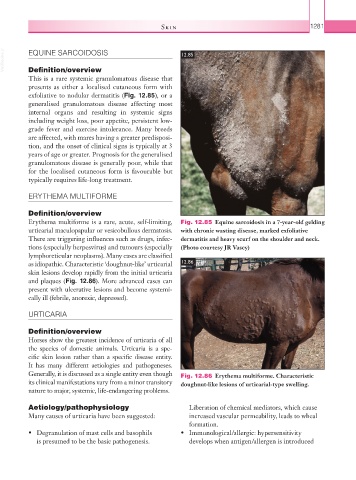Page 1306 - Equine Clinical Medicine, Surgery and Reproduction, 2nd Edition
P. 1306
Skin 1281
VetBooks.ir EQUINE SARCOIDOSIS 12.85
Definition/overview
This is a rare systemic granulomatous disease that
presents as either a localised cutaneous form with
exfoliative to nodular dermatitis (Fig. 12.85), or a
generalised granulomatous disease affecting most
internal organs and resulting in systemic signs
including weight loss, poor appetite, persistent low-
grade fever and exercise intolerance. Many breeds
are affected, with mares having a greater predisposi-
tion, and the onset of clinical signs is typically at 3
years of age or greater. Prognosis for the generalised
granulomatous disease is generally poor, while that
for the localised cutaneous form is favourable but
typically requires life-long treatment.
ERYTHEMA MULTIFORME
Definition/overview
Erythema multiforme is a rare, acute, self-limiting, Fig. 12.85 Equine sarcoidosis in a 7-year-old gelding
urticarial maculopapular or vesicobullous dermatosis. with chronic wasting disease, marked exfoliative
There are triggering influences such as drugs, infec- dermatitis and heavy scurf on the shoulder and neck.
tions (especially herpesvirus) and tumours (especially (Photo courtesy JR Vasey)
lymphoreticular neoplasms). Many cases are classified
as idiopathic. Characteristic ‘ doughnut-like’ urticarial 12.86
skin lesions develop rapidly from the initial urticaria
and plaques (Fig. 12.86). More advanced cases can
present with ulcerative lesions and become systemi-
cally ill (febrile, anorexic, depressed).
URTICARIA
Definition/overview
Horses show the greatest incidence of urticaria of all
the species of domestic animals. Urticaria is a spe-
cific skin lesion rather than a specific disease entity.
It has many different aetiologies and pathogeneses.
Generally, it is discussed as a single entity even though Fig. 12.86 Erythema multiforme. Characteristic
its clinical manifestations vary from a minor transitory doughnut-like lesions of urticarial-type swelling.
nature to major, systemic, life- endangering problems.
Aetiology/pathophysiology Liberation of chemical mediators, which cause
Many causes of urticaria have been suggested: increased vascular permeability, leads to wheal
formation.
• Degranulation of mast cells and basophils • Immunological/allergic: hypersensitivity
is presumed to be the basic pathogenesis. develops when antigen/allergen is introduced

